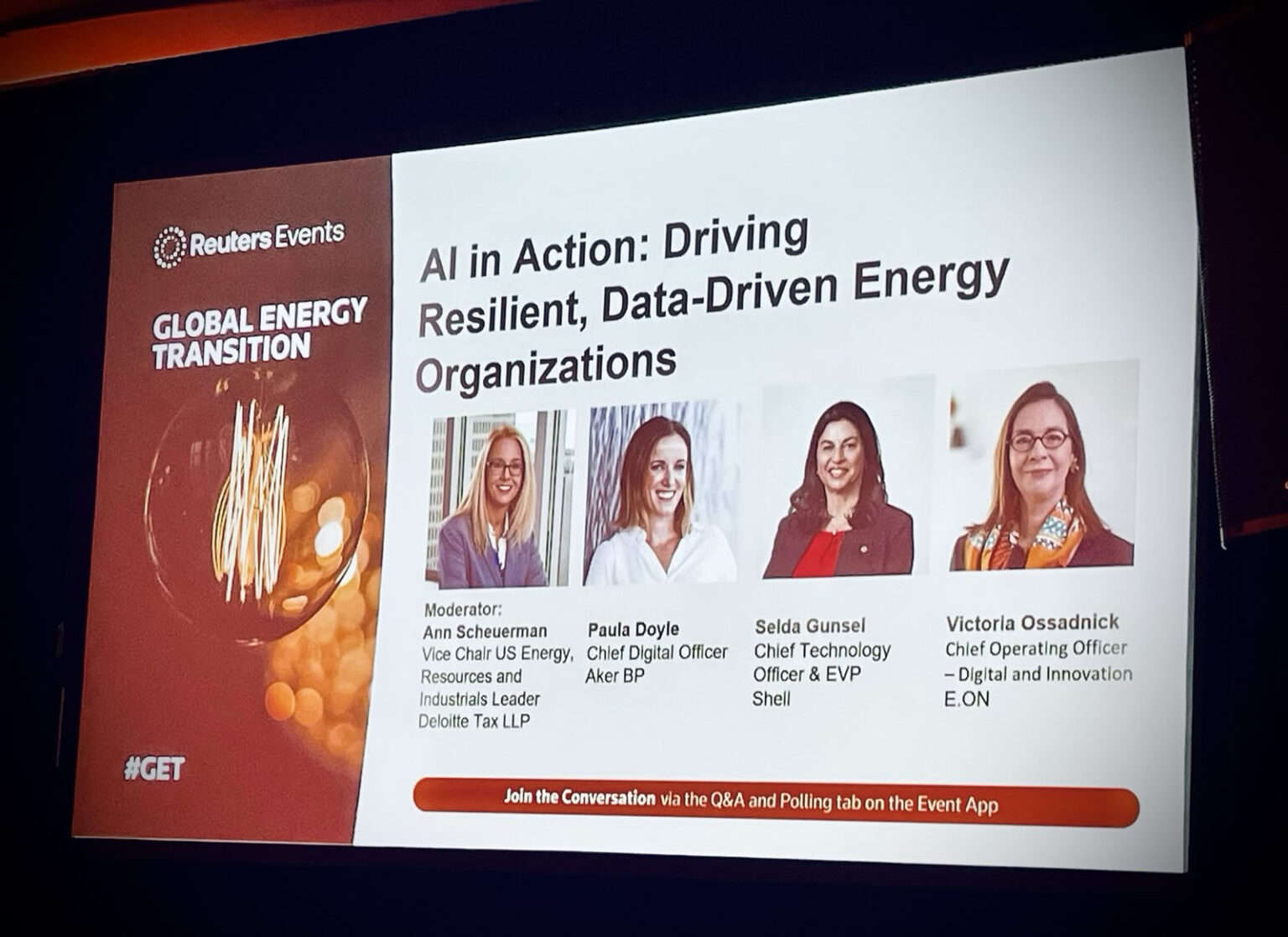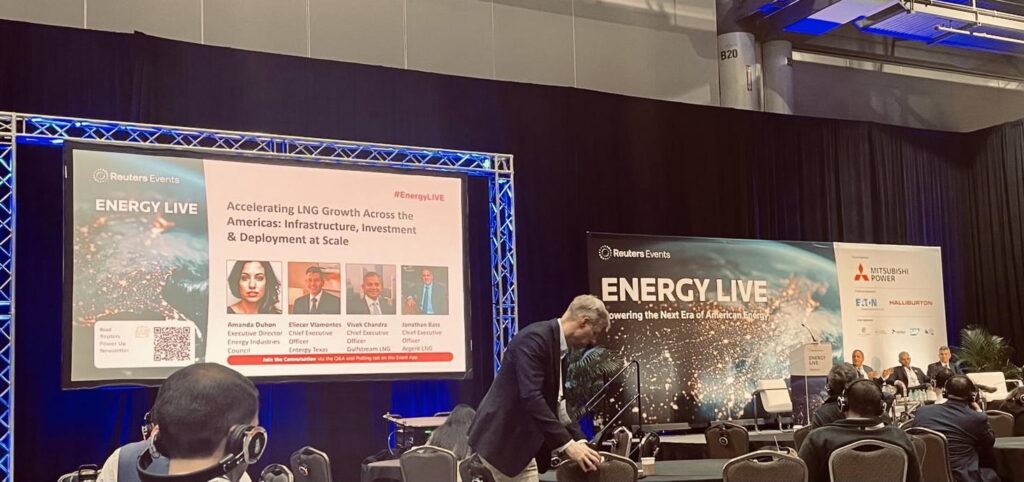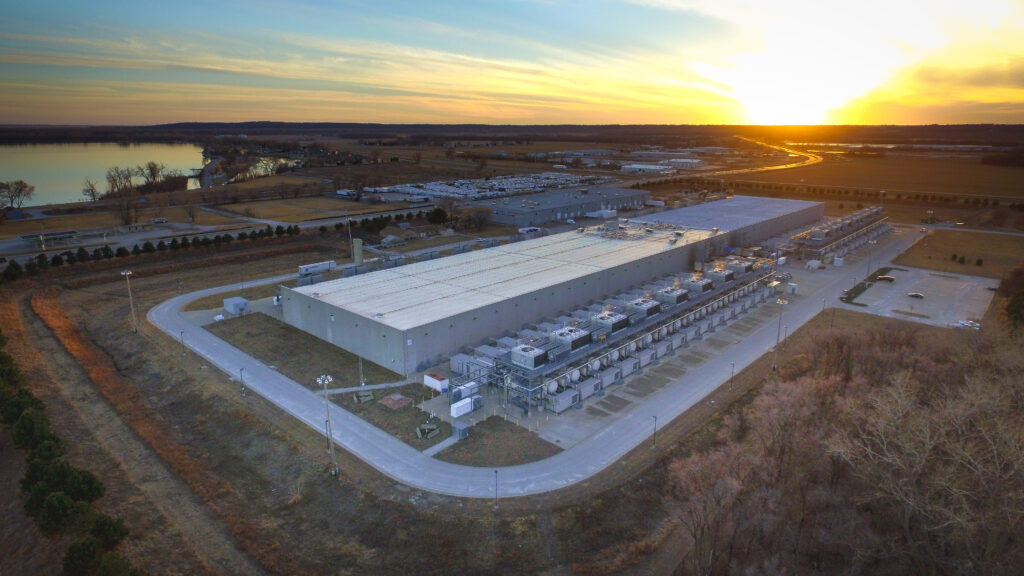Artificial intelligence (AI) use is spreading rapidly among oil drillers and other fossil energy companies — and some are now promoting plans to give “agentic” or autonomous AI key roles in risky real-world operations like drilling for oil and keeping the nation’s power grids up and running.
Amid the Trump administration’s push to promote AI development, oil and gas companies are exploring ways AI can boost their profitability, from coaxing more oil from aging wells to finding untapped oil deposits or driving down maintenance costs, according to industry insiders who spoke at an energy conference attended by DeSmog.
“We are already seeing the implementation of AI in making a difference in shaping our energy system,” Selda Gunsel, chief technology officer for Shell, told the Reuters Global Energy Transition conference in June. “Today, we have more than 100 AI-based applications and it’s integrated into every line of our business.”
Subscribe to our newsletter
Stay up to date with DeSmog news and alerts
While fossil fuel companies tend to highlight AI’s potential to help reduce emissions, the numbers suggest that’s not their primary focus.
“I would say about 70 percent of our technology effort is focused on improving the competitiveness of our current businesses, whether it’s in upstream, downstream, renewables or integrated [LNG and natural] gas,” Gunsel told conference attendees.
Shell’s current businesses are, of course, heavily weighted towards fossil fuels, with the oil giant’s renewables division reporting a small loss in the company’s adjusted earnings last quarter while its upstream, downstream, and integrated gas divisions drove profits.
Already, 44 percent of oil and gas drillers are using AI “in oil and gas exploration,” a May survey of 105 top oil and gas executives by the IBM Institute for Business Value found. “Another 45% plan to do so within three years.”
Just 14 percent of oil and gas producers said they use AI for emissions monitoring, leak detection, and other environmental tools, IBM’s survey found.
Twice as many (28 percent) reported using AI for oil and gas drilling. And they’re just getting started: 85 percent of producers said they intend to use AI for drilling within a few years — while a similar number (89 percent) said by then they’ll also be using AI to explore for new deposits of oil and gas.
United Nations Secretary General António Guterres said in 2023 that all investments in finding new fossil fuels needed to end worldwide to avoid “climate catastrophe.”

“We have this year come out and said that we expect everybody in Aker BP is using AI in their work,” Paula Doyle, chief digital officer for Aker BP, Europe’s largest independent oil and gas producer, told the Reuters conference. “It’s not acceptable kind of not to be curious about it and see how you can use it in your day to day. We’re using AI in performance reviews and related to salary reviews.”
Big Oil’s use of AI is calling into question the technology’s climate impacts — already under fire over the extraordinary energy demand caused by AI data centers.
“Tech leaders and governments justify further investment in AI systems by emphasizing it as a tool for sustainability,” over 100 civil society organizations wrote in a joint statement for the AI Action Summit held in Paris earlier this year. “However, AI can never be a ‘climate solution’ if it runs on fossil fuels and is used to extract oil and gas.”
The groups called on tech companies to “immediately disclose and end contracts that provide AI to the oil and gas industry especially for the purposes of exploration and drilling.”
Shell and Aker BP declined to comment for this article. Aker BP has said AI will play “a central role in how we operate,” and that its AI strategy includes “ensuring AI is implemented ethically and responsibly.”
Many of the tech industry’s biggest companies explicitly market their AI products to oil and gas companies worldwide — including launching partnerships with oil companies.
Chipmaker NVIDIA, for example, touts “success stories” from Saudi Aramco, Shell and Petrobras on a web page the tech company devotes to oil and gas operations.
A Self-Driving Power Grid?
One of the newest advances in AI is agentic AI – artificial intelligence tools that don’t just advise or inform people, but are allowed to directly interact with the real world, independently.
“We believe that, in 2025, we may see the first AI agents join the workforce and materially change the output of companies,” OpenAI founder Sam Altman wrote in January. Last week, Wells Fargo announced the rollout of agentic AI across its global banking business, from investment banking to customer relations.
Electrical utilities, meanwhile, have begun exploring ways to incorporate autonomous AI in the nation’s power grid. That’s driven, in part, they say, by the need to handle intermittent generation from renewable energy (a problem many states are handling today in part by adding increased battery storage alongside renewables).
“Right now the lowest cost resource is actually solar and batteries,” Jim Taylor, vice president of Energy Solutions for Siemens Smart Infrastructure, told the Reuters Global Energy Transition conference. “As we add more and more solar to the system, the system becomes more and more intermittent, and intermittency right now is managed by a person standing in a control room pushing buttons that trigger things to happen in the field. We call it a ‘man in the middle.’”

“Every utility globally has the same thing,” he said. “There’s a man in the middle that’s actually making the decisions of how the grid is going to function. If there’s a change or a modification to the grid, they have to react to it. They have to know what to do and how to respond to that.”
“That man in the middle is just not going to work in the future. The intermittency is going to drive that we can’t react fast enough,” he continued. “And so we need to move more towards machine interface or machine learning and AI and things of that nature to build an autonomous control system so that we can manage the grid autonomously — and then the humans are just going to see how the reaction went.”
“They won’t be the primary control,” he said.
It’s worth bearing in mind that renewables are hardly the only reason utilities are grappling with intermittent power generation. Natural gas production, for example, can dip during winter storms, the Energy Information Administration notes — a major factor in the deadly power blackouts that swept Texas in 2021.
“We don’t talk enough about the intermittency problem with fossil fuel and nuclear plants, which need water to cool themselves,” 350.org founder Bill McKibben observed in an August 7 Substack post, citing the effects of heatwaves and extreme weather on coal and nuclear power plants across the EU this summer.
AI Drills for Oil
Fossil fuel producers are also exploring how they can use agentic AI directly in their own operations.
IBM found nearly a third of oil and gas drillers were “piloting agentic AI optimization” for activities like preventing well blowouts.

Industry advisors are pushing oil and gas companies to use AI for far more than simply drafting emails or reports.
“Leadership must also tolerate — and even encourage — risk-taking with AI,” a note from the Big Four accounting firm EY (formerly known as Ernst & Young) for oil and gas companies advises. “It’s easy to green-light AI investments for productivity enhancements such as routine back-office functions, but it can be a much tougher decision to champion AI use in subsurface decisions, where millions of dollars are at stake. That said, the reward is also potentially higher.”
How to Handle AI Liability
Of course, it’s not simply money at stake when oil and gas drilling is involved. There’s the risk of oil spills, deadly accidents, drinking water contamination, and a host of other perils associated with oil and gas accidents.
And that means courts may soon face untested legal theories as they consider how to handle the question of liability for agentic AI’s decision-making.
Last week, a federal jury ordered Tesla to pay $243 million in damages for the role the car-maker’s self-driving “Autopilot” feature played in a deadly 2019 car crash. “Today’s verdict is wrong and only works to set back automotive safety and jeopardize Tesla’s and the entire industry’s efforts to develop and implement life-saving technology,” Tesla told NBC News in a statement, adding that it plans to appeal.
There’s an extremely wide range of ways that companies can use AI, ranging from highly specialized machine-learning tools to consumer-grade AI assistants like Microsoft Copilot.
“Our adoption for Copilot, for example, is at 96 percent, which is incredibly high,” Aker BP’s Doyle told the Reuters conference.
Of course, novel technology brings with it new risks, and some of the risks associated with AI are only just starting to emerge. Microsoft, for example, revealed this summer that it had fixed a major flaw that could have allowed hackers to access any data CoPilot has access to, including Teams conversations, chat histories, and internal documents, without any user interaction — a flaw cybersecurity experts call a “zero-click” vulnerability. A Microsoft spokesperson told trade publication Cybersecurity Dive that the issue had been fixed “before our customers were impacted.”

At the Reuters conference, Paula Doyle of AkerBP told attendees that her oil production company is concerned about AI hallucinations. Credit: Facebook/AkerBP ASA
Hallucination-free AI?
CoPilot isn’t alone. Another zero-click vulnerability, this time involving ChatGPT, was revealed at the Black Hat hacker conference in Las Vegas on August 6, according to Wired.
There’s also perhaps AI’s most widely-known problem: its tendency to hallucinate.
“One of the concerns that our operations guys have around AI is hallucinations,” said Aker BP’s Doyle. She described how the oil company partnered with a company called Cognite, which promises “hallucination-free” AI. She also argued that generative AI has come a long way since 2023.
“If you look at the latest benchmarking, I mean, you basically have unlimited access to PhDs,” said Aker BP’s Doyle. “That’s the reality. Yet people still talk about it as like a kind of excited intern.”
That said, hallucinations remain a problem for generative AI, prompting concerns about relying on common AI tools in fields like healthcare. A study published in Nature Aug. 2, by the Mount Sinai Icahn School of Medicine, for example, warned that AI-generated summaries of patient notes “frequently contain errors that can be hard to detect.” It added that errors contained in user prompts can spur hallucinations, “potentially misleading clinicians, misinforming patients, and harming public health.”
The newly rolled-out ChatGPT-5 promises fewer hallucinations, with OpenAI saying the update reduces incorrect answers from 12.9 percent to 9.6 percent. “While that’s definite progress, that also means roughly one in 10 responses from GPT-5 could contain hallucinations,” Mashable notes.
Big Oil Still Uneasy About AI
Within the fossil fuel industry, there’s apprehension about AI, the oil and gas law firm Oliva Gibbs noted in a March report. “Without a clear grasp of how AI technology reaches its conclusions, a lack of trust accompanies employees’ unease,” attorneys Molly Pella and Isabel Hunstman wrote. “In absence of understanding the ins and outs of how AI works, some are skeptical that AI can properly account for all the what-ifs and review all the information to provide a reliable result.”
“This speed of change in this technology — I mean, even though we are a very technical industry, people just don’t believe that,” Victoria Ossadnick, chief operating officer for E.ON, one of Europe’s largest power and gas utilities, told the Reuters conference. “And even if they play with it, even if they do it privately, it’s this thing of, do I really trust that?”
She described E.ON’s use of AI in energy market trading, saying that the company ran an experiment by letting an AI system run in parallel to its human energy market counterparts for a year — and found that the AI would have made “significantly more money” for the company.
“Now the next step is the grid,” she said.
But she argued there’s also a need for speed, meaning there’s little time for similar testing as AI is rolled out in new areas. “You need to prove and prove and actually and that’s my worry,” she said. “We don’t have the time for that. We don’t have time to have one year running stuff in parallel.”
“AI is substantially and very deeply changing all our business models. And this is uncomfortable. But this disruption is there,” she told the Reuters conference.
“This AI stuff, it’s costing us as societies,” she added. “As companies, it’s costing us a lot of money — so it needs to create much more value.”
Subscribe to our newsletter
Stay up to date with DeSmog news and alerts






